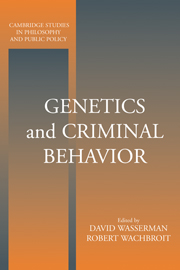Book contents
- Frontmatter
- Contents
- List of Contributors
- Acknowledgments
- 1 Introduction: Methods, Meanings, and Morals
- PART I
- 2 Understanding the Genetics-of-Violence Controversy
- 3 Separating Nature and Nurture
- 4 Genetic Explanations of Behavior: Of Worms, Flies, and Men
- 5 On the Explanatory Limits of Behavioral Genetics
- 6 Degeneracy, Criminal Behavior, and Looping
- 7 Genetic Plans, Genetic Differences, and Violence: Some Chief Possibilities
- PART II
- Index
4 - Genetic Explanations of Behavior: Of Worms, Flies, and Men
Published online by Cambridge University Press: 05 June 2012
- Frontmatter
- Contents
- List of Contributors
- Acknowledgments
- 1 Introduction: Methods, Meanings, and Morals
- PART I
- 2 Understanding the Genetics-of-Violence Controversy
- 3 Separating Nature and Nurture
- 4 Genetic Explanations of Behavior: Of Worms, Flies, and Men
- 5 On the Explanatory Limits of Behavioral Genetics
- 6 Degeneracy, Criminal Behavior, and Looping
- 7 Genetic Plans, Genetic Differences, and Violence: Some Chief Possibilities
- PART II
- Index
Summary
INTRODUCTION
For several hundred years scientists and philosophers have speculated about the character and scope of explanations of a particular type, where that type might be, for example, “mechanical,” “chemical,” “electrical,” and, more recently, “biochemical,” “molecular,” “selectional,” “developmental,” “adaptational,” and “genetic.” Extensive discussions about “mechanical” explanations are an interesting and useful analogous problem to the one that is the subject of the present chapter, especially in the context of nineteenth-century debates about the reach of mechanics, because it was thought for much of that century that all of physics and, ultimately, all natural science were susceptible to a reductive “mechanical explanation.” In a sense, in biology, genetics now plays the part that mechanics did for nineteenth-century physics. Philosophy of science in the twentieth century has been less interested in general unificatory or in special-science explanations, though there are important exceptions, including some in recent philosophy of biology. E. Nagel's analysis of “What is a mechanical explanation?” (1979, 153–174) is one exception that discusses a special-science explanation, and that in-depth examination offers some useful methodological suggestions that can be generalized to the topic at hand.
Mechanics and Mechanical Explanations
Nagel's analysis of “mechanical explanation” points out that the terms “mechanical” and “mechanics” admit of a number of different senses, so many in fact that he concludes, preanalytically at least, “there is no core of precise meaning common to these usages” (1961,156).
- Type
- Chapter
- Information
- Genetics and Criminal Behavior , pp. 79 - 116Publisher: Cambridge University PressPrint publication year: 2001

